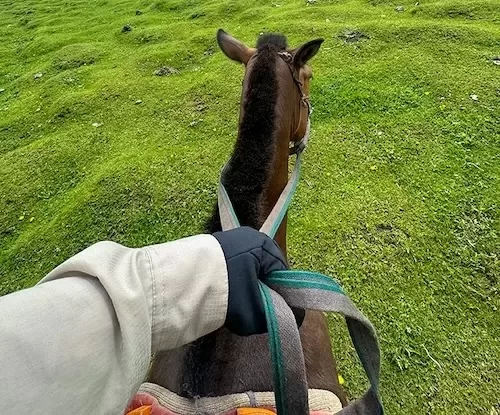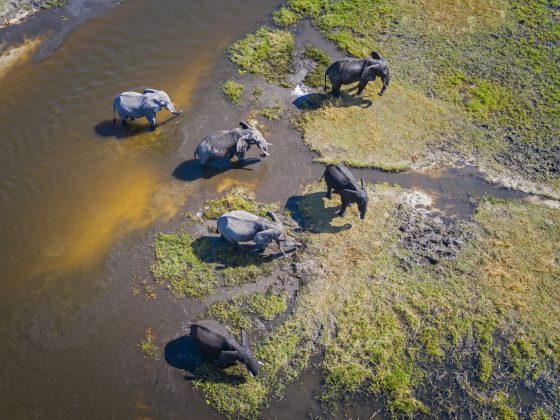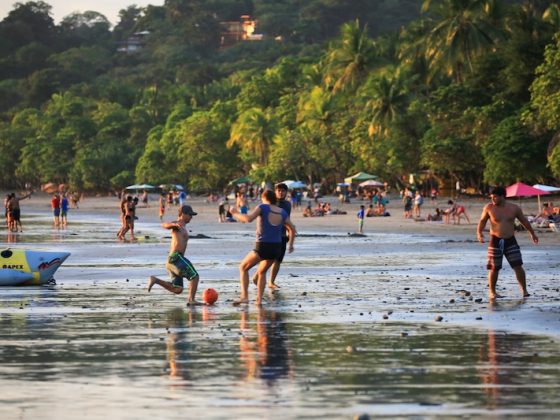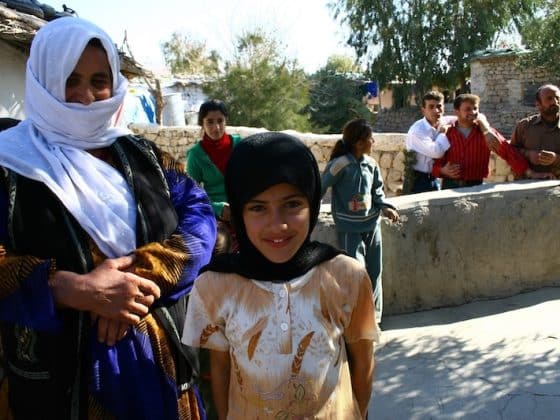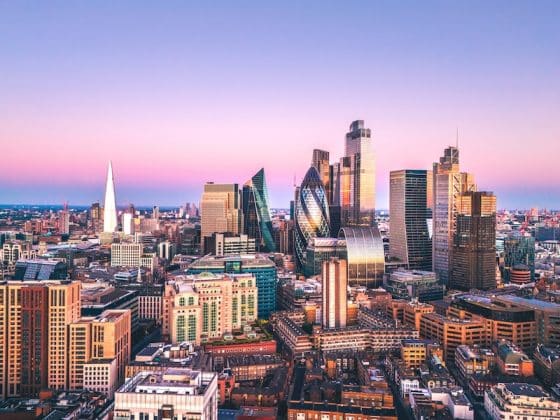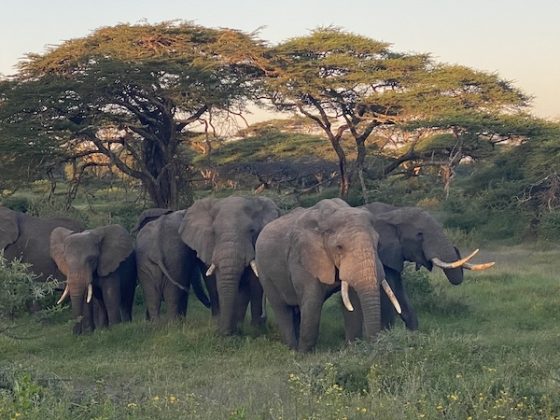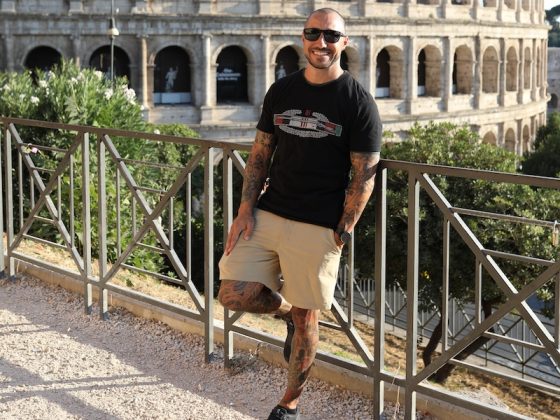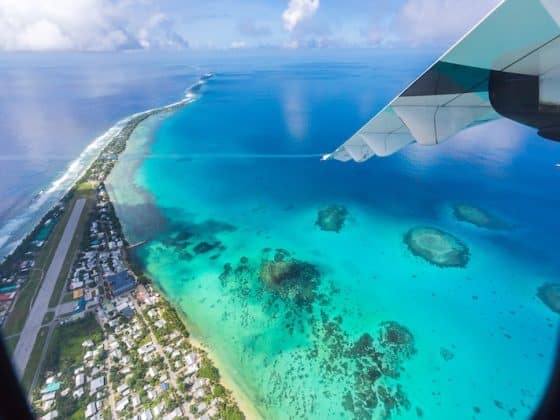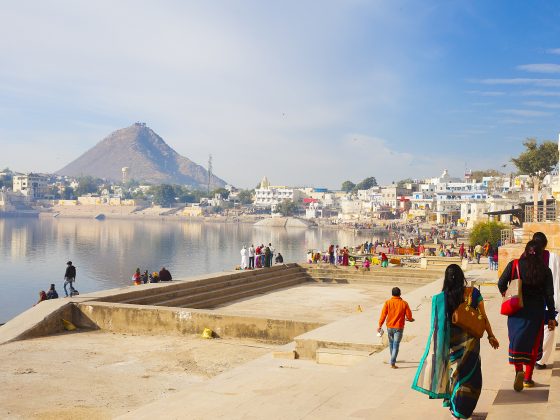Mongolians don’t typically name their horses, but the 7-year-old bay gelding I’m paired with for a three-day steppe and wilderness trek finds a cheeky way to reveal his to me: Boss. His regular refusal to obey my commands shows he considers himself in charge and his persistent side-eye makes it clear he wants everyone to know it.
“He has a free spirit like you,” is the explanation I receive for why I’ve been paired with this obstinate animal. While I take the character analysis as a compliment, I also know this will be no pony ride.
I found myself atop this intrepid creature after my years of scheming finally reached fruition; riding a horse across the Mongolian steppe had long been a dream of mine.
Read more like this: Bellissima Lucca, a Pilgrim’s Journey
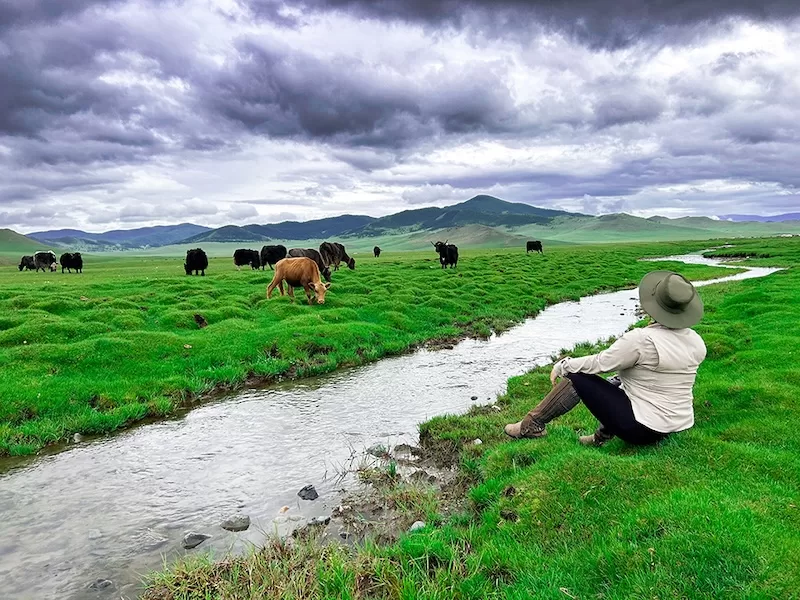
Mongolia seemed to promise the type of raw adventure that’s so hard to find today, when so many wonderful destinations have been globalized and commodified into local versions of Barcelona or Times Square. I can’t stop the forward march of time and commerce, but I can seek out the lost corners of the world that still hold mystery.
I’ve ridden horses since childhood, but never took the hobby too seriously. For me, it was always about the freedom of bonding with a majestic, powerful animal to forge new paths to remote lands. From Costa Rica to Argentina, New Zealand to Iceland, I have saddled up at any opportunity, and in doing so, earned my rank as a lifelong intermediate equestrian.
But unlike my rides elsewhere, Mongolia was intentional. I went there to ride. And it was on one of those trips where all the details seemed pulled together by fate.
I had planned to visit Mongolia in late 2020, but the pandemic delayed the trip indefinitely. As the world began opening up in early 2022, the massive landlocked nation tugged at the corners of my mind. When my travel writer friend Breanna Wilson reached out to tell me she had moved to Mongolia and started leading adventure tours, including multi-day horse expeditions, I knew the time had finally come.
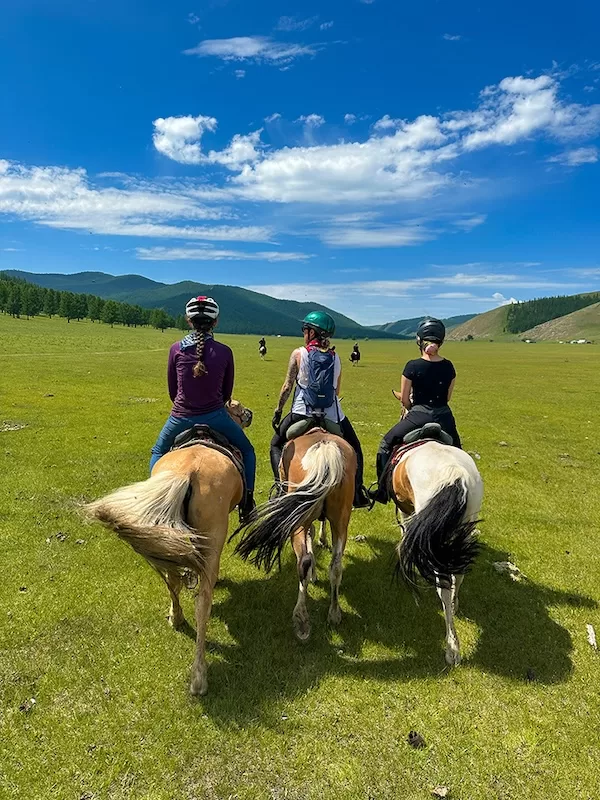
Breanna and I weren’t the only ones in our age bracket captivated by Mongolia’s mysterious magic. The Mongolian government has smartly begun reaching out to influencers and younger travelers, showcasing the country’s untamed, off-grid status, and it’s begun to pay off. Countless Millennials have been drawn by the chance to ditch their screens and head into the wild. As the last generation to experience life before ubiquitous technology, Mongolia offers a respite from constant connectivity plus the hardcore adventure so many of us desire.
Despite the increased attention, getting to Mongolia remains an adventure in and of itself. There are no direct flights from the United States, or hardly anywhere else. After a visit to Bangkok, I flew to Hong Kong and boarded a full Mongolian Airlines flight to Ulaanbaatar. Most of my fellow passengers seemed to be Mongolians returning home. With the help of my new neighbors, I spent my flight trying to memorize a few key phrases in Mongolian, my lips stumbling over sounds I’d never before uttered. I relished the experience of delving into the unknown, soaking up every ounce of novelty.
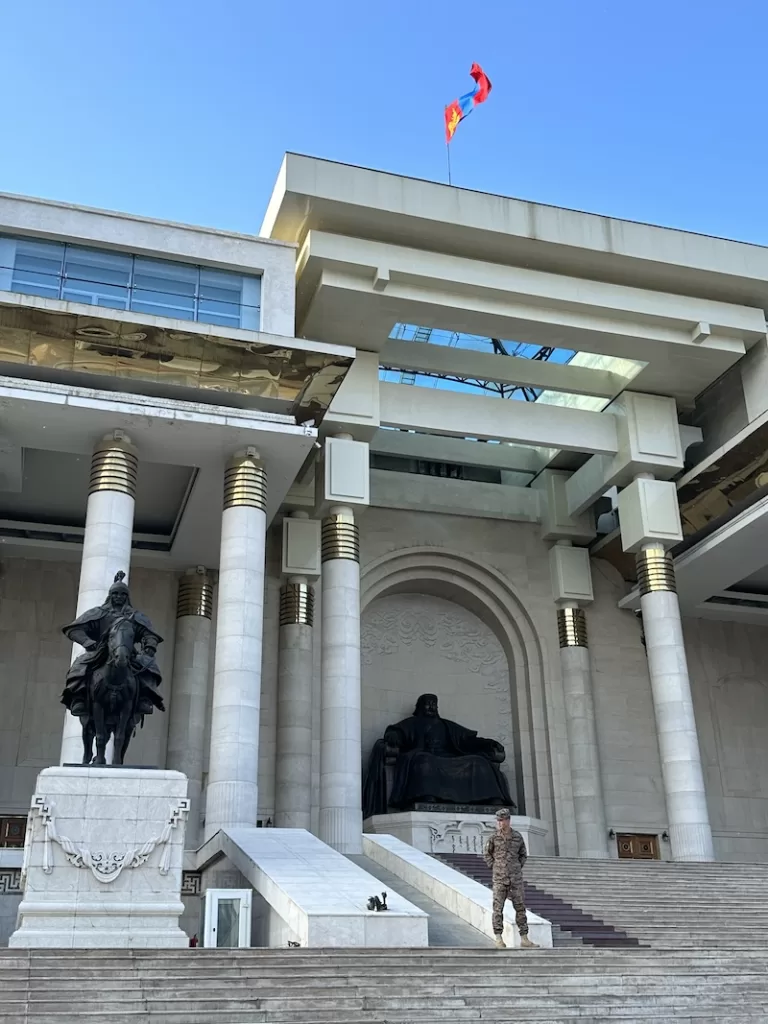
It’s a whole lot of something in the midst of a staggering nothing, with teetering gray skyscrapers, smoke-spewing vehicles jam packed on the roads, and at least upon my arrival, relentless rainfall.
I loved the place immediately.
Upon landing, Breanna welcomed me to a city unlike anything I had ever seen or could have expected. Even photos can’t quite capture the shock of the Mongolian capital’s brutalist echo of the Soviet era, with barren hills rising to the horizon in every direction. It’s a whole lot of something in the midst of a staggering nothing, with teetering gray skyscrapers, smoke-spewing vehicles jam packed on the roads, and at least upon my arrival, relentless rainfall.
I loved the place immediately.
We spent a few days kicking around the city while the rest of our group assembled. There was enough time to do essential shopping, including high quality cashmere clothing at high-end retailer Gobi, and eclectic chaos at the indoor/outdoor Black Market, where locals set up stalls selling just about anything you can imagine. Traditional deels, socks woven from camel hair, knock-off designer shoes—you name it. (Pro tip: head to the top floor of the inside part of the market to find a food court that will get you well-acquainted with true Mongolian barbecue.)
On our first night as a group, Breanna and her colleague and translator Aagie briefed us on local culture and customs. Countless families beyond the city’s limits, and some within Ulaanbaatar as well, still live in round, portable gers (Mongolian yurts) that enable their traditional nomadic lifestyle. Ger means home in Mongolian, and families pack them up to relocate as the seasons change. A lot is packed into these small, circular dwellings, including centuries of tradition.
“You will be greeted with something white first—milk, tea, even yogurt in summer—as a symbol of purity,” Breanna explained. “Sometimes vodka will be offered in a silver bowl, and it’s meant to be passed back to the host after you take a sip.” I mentally fortified my stomach when she said declining wasn’t an option. I was chasing novelty, after all.
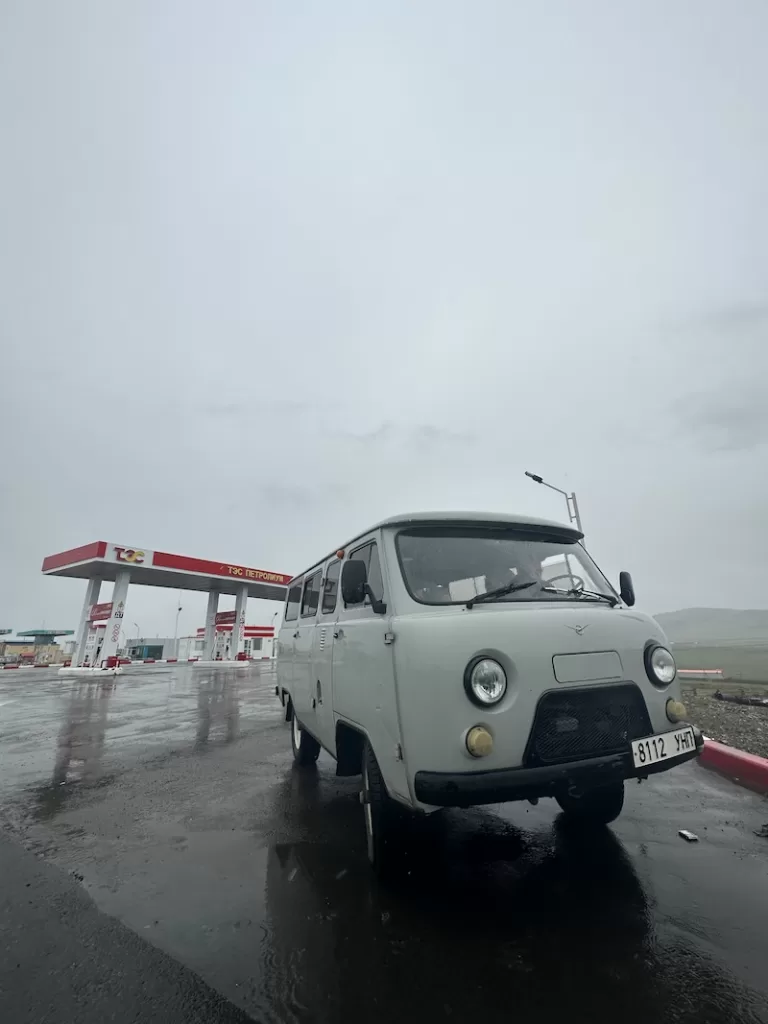
We hit the road early the next morning in a Russian furgon, a large van capable of long journeys. While the exterior was a forgettable, Soviet gray, the interior boasted shag carpeting, a faux-crocodile skin roof, seats shrouded in an unusual, brass-colored fabric, and a barrier between we passengers and our driver, Gambat (the T is silent).
I was shocked to learn the vehicle had been built in 2018, not 1967.
A steady rain fell as we wended our way out of Ulaanbaatar, the roads slick with floodwater. “We’re swimming in Genghis Khan’s tears,” Breanna remarked, the first of many Khan references I would encounter during my visit.
Born in the Khentii Mountains in the country’s northeast, Genghis Khan founded the first Mongol Empire in the late 12th century. Though he only reigned supreme across the steppe for a few decades, he left a lasting mark. He united the tribes of Mongolia and created the world’s most fearsome fighting force, which swiftly conquered much of Asia and eastern Europe.
After his death, the famed Mongol Hordes continued the expansion, creating perhaps the largest empire to ever exist. He gained a reputation for brutality, but his legacy has indelibly shaped Mongolia and remains a point of pride and honor among modern Mongolians. In this country, you don’t mess with Genghis Khan’s memory.
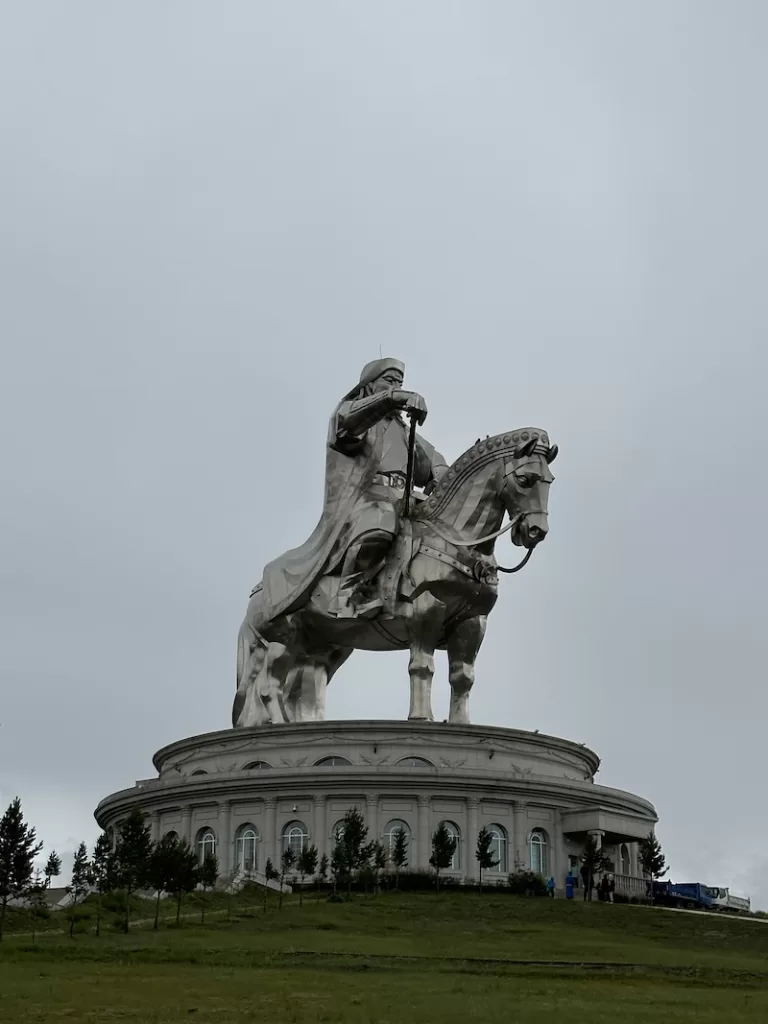
Our sights were set west to the town of Tsetserleg in Arkhangai Province, where our horse trek would begin. The road was long, unpaved, and arduous, and therefore perfectly charming. Wildlife reared its lovely head: golden eagles on fences, Demoiselle cranes in ponds, buzzards pecking at horse corpses.
As for the landscape, imagine if your neighbor had an endless, deep-green lawn occasionally interrupted by rocky crags and peppered with loose confederacies of livestock, including goats, sheep, horses, yak, cattle, and two-humped Bactrian camels. There are piles of bones everywhere, and sacred ovoos draped in blue scarves, the decorated piles of rocks and bones looking more like impromptu gravestones than the border markers or shrines they are.
Canvas gers with intricately-painted orange or blue doors dot the hillsides, and I’m reminded of their temporary nature when we pass families either building or dismantling their homes. There are plenty of permanent structures too, but it’s clear the nomadic way of life is alive and well in Mongolia—as it is among many of today’s digital travelers.
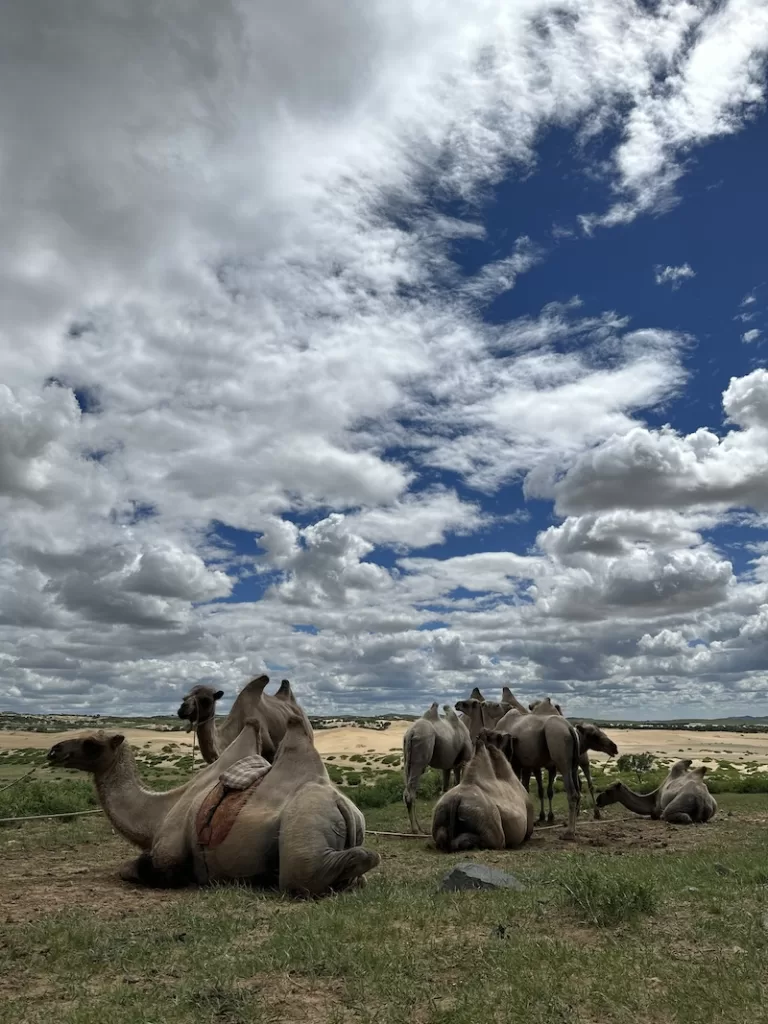
A few hours in, Breanna steers us into so-called Mini Gobi, a reverse oasis of sand surrounded by grassland at the edge of the Arkhangahi, for a surprise camel ride. There is little sign of life beyond a few gers. As a herding family ushers us into their home, Breanna reminds us to stay on the left side of the ger after we enter, as the right side is reserved for the family. We are greeted with a bottle of smokeless tobacco, airag, or fermented mare’s milk (surprisingly delicious, reminiscent of kombucha), and steaming buuz (dumplings) filled with mutton and beef.
After, we climb aboard our dromedaries and head into the dunes. These Bactrians are wonky vessels, obstinate and aloof; mine, which I’ve named Yeehaw, has no interest in my commands. But he makes quick work of the sandy surrounds, and I’m romanced by the scene. Swooping falcons against an endless sky, unfenced land inspiring a sense of total freedom. I could get used to this.
Back in the furgon, we chug toward our destination, stopping for gas and snacks. Road tripping speaks an international language. We fill our arms with chips, candy, and sodas, some familiar American brands among the mostly-Korean options.
Mongolian beef jerky is the clear top-tier snack, though it’s not always beef. In an adventurous moment, I grab a carton of camel’s milk for the road, but Aagie pulls it from my hand and puts it back, gently telling me it has a laxative effect.
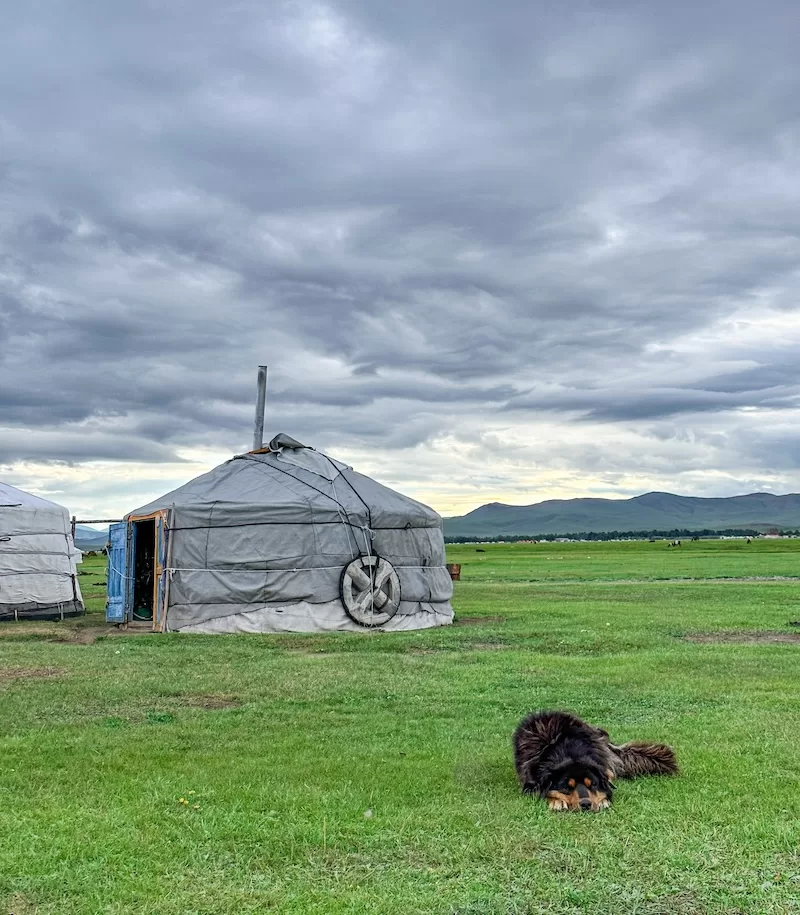
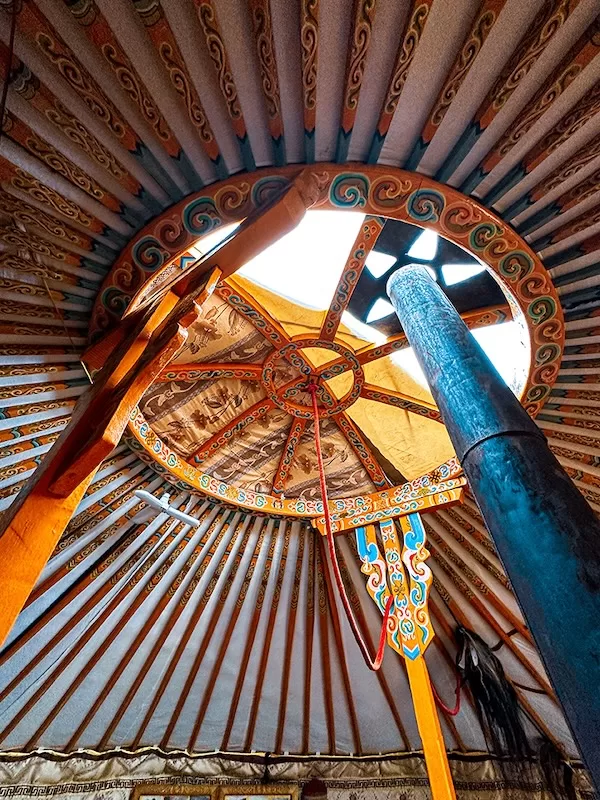
We arrive after stars have replaced the sun in the unbroken sky, and check into the Fairfield Guesthouse in Tsetserleg to enjoy our last night sleeping in a bed for several days. Once our horse trek commences the following morning, we will rely on the hospitality of nomadic families to invite us to stay in their gers.
The next day I meet Boss, though I don’t yet know his name. As one of the more experienced riders in our crew, I mistakenly requested a spirited animal for our journey. Fun fact: they’re all spirited, but mine just may be the liveliest of them all.
Boss is part of a large herd of semi-wild horses managed by a family Breanna has come to know over the years. We are graciously welcomed into their ger and offered the aromatic aaruul (dried cheese curds) every family seems to be preparing in advance of the upcoming annual Naadam Festival, around which our trip has been planned. Naadam, which means, simply, “games,” is an annual celebration of traditional Mongolian culture, where communities gather to compete in horse racing, wrestling, and archery. It’s said that aaruul keeps Mongolian teeth healthy, but it makes my mouth sad. These sour nuggets are not for me.
Finally, it’s time to embark on a journey a lifetime in the making. We load up onto our horses, local guides toting our bags on designated pack horses, and set out into the steppe.
The going is rough as we adjust to the weather and the whims of our animals. We vacillate from sweating into our shirts to shivering under rain gear, clouds arriving as swiftly as they depart. It is undeniably invigorating, as the bruises on my body will later remind me. We pass through yak herds and neighborhoods of gers—all gers are technically in a neighborhood even if you can’t see the neighbors.
Truly wild horses eye our steeds suspiciously. We ride for several hours through grassland, forested hills, and a spongy bog that feels straight out of a fantasy realm. By the end of the first day, my horse’s bossy nature reveals his name to me, and we begin the process of learning to work together.
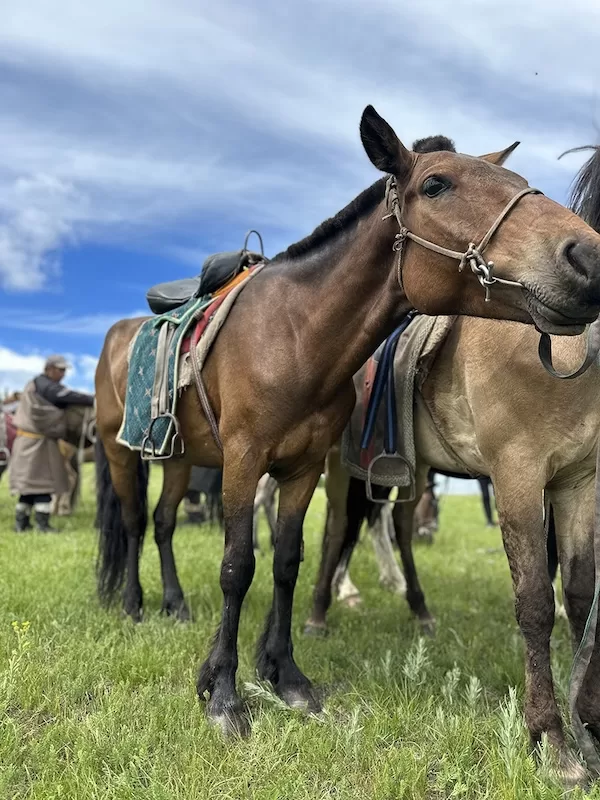
“People say horse riding is in our blood. I’m not sure about that. But this,” Aagie says, gesturing to the hospitality we’ve been eagerly provided, “this is who we are.”
Finally, we arrive at a collection of gers, one of which, we hope, will house us for the night. But nobody is home, so we cross the field to a ger-in-progress, helping the family and neighbors build it. This is their summer ger. And I know this because when I asked where they had come from, they told me their winter ger.
The grandchildren of the neighboring ger join us at the build, bringing us fistfuls of dandelions and wildflowers while we work. We are beckoned to visit two chained Mongolian mastiff puppies, and the kids show us how to pet them without getting bit. Later by the creekside, they try to teach us some words, mostly body parts. They seem to place great emphasis on the elbow (tokhoi) for some reason. “People say horse riding is in our blood. I’m not sure about that. But this,” Aagie says, gesturing to the hospitality we’ve been eagerly provided, “this is who we are.”
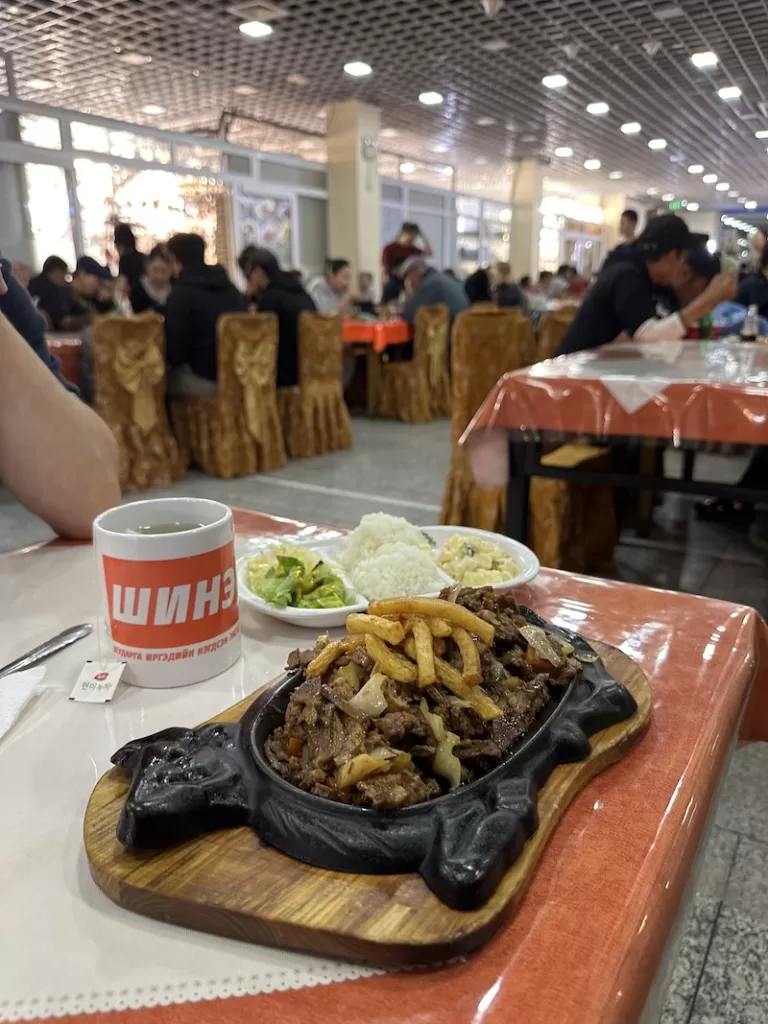
For dinner, our host family prepares a generous serving of tsuivan, a delicious noodle dish. Once the sun has gone down, the yaklings have been fed, and everyone is feeling the strain of a hard day’s ride, we unfurl our sleeping bags and fall into peaceful slumber.
The next few days proceed in a similar fashion as we explore the expansive steppe. Rolling fields give way to flower-filled mountainsides, low-lying forests occasionally providing respite from the sun. Even the first-time riders are galloping now, the breakneck speed of our horses being the best way to outrun the biting flies that irritate us all.
Over the course of our journey I notice the qualities we share. I understand why we were paired—and what it means to be a free spirit.
We happen upon a local Naadam festival, where a raucous community is gathered to partake in traditional wrestling and horse races. They tell us it’s the smallest Naadam in Mongolia, and being unable to verify this makes it all the more magical: instead, we exist in a world of wonder, where hyperbole may be reality.
Slowly, Boss and I learn to trust each other. Over the course of our journey I notice the qualities we share. I understand why we were paired—and what it means to be a free spirit. We value freedom, and resent anyone who threatens our independence. We are selective about who we let into our lives, and even more so our personal space. We prefer to move fast and respond to strong leaders who take the time to earn our loyalty.
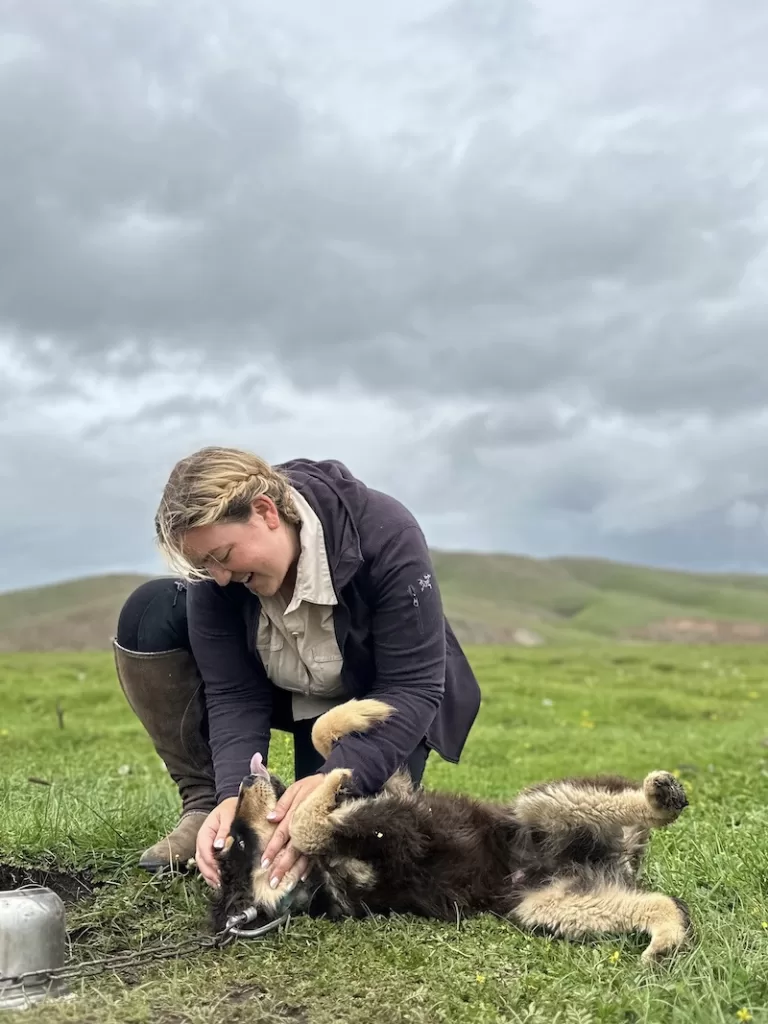
Boss might not be a people-pleaser, but he carried me through landscapes I could have never imagined, letting me experience the singular sensation of galloping across the Mongolian steppe, blissfully severed from the constraints of time. We will never see each other again, but I’ll never forget how he reminded me that it’s a good thing to be a little bit wild.
———————
California-based writer Ali Wunderman has contributed to Conde Nast Traveler, Travel + Leisure, The Guardian, Washington Post, and many other top outlets. She won the 2022 Lowell Thomas bronze award for Travel Journalist of the Year and is the author of Fodor’s Guidebook to Belize. Follow her travels on Instagram and find more of her work on her website.
Ali Wunderman
Contact Author
"*" indicates required fields
Stay Ahead on Every Adventure!
Stay updated with the World News on Escape Artist. Get all the travel news, international destinations, expat living, moving abroad, Lifestyle Tips, and digital nomad opportunities. Your next journey starts here—don’t miss a moment! Subscribe Now!
